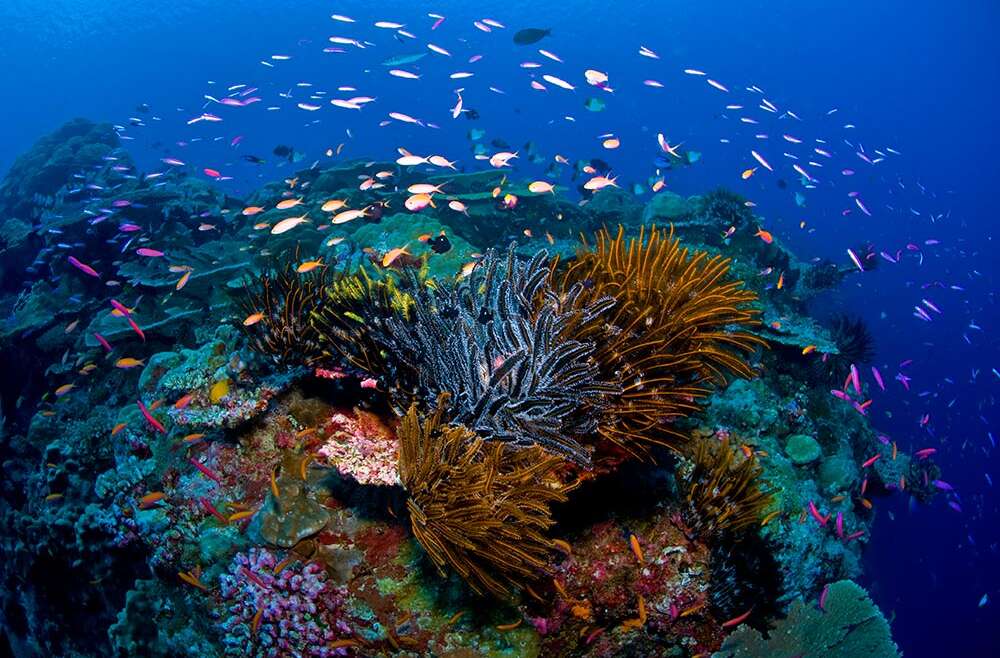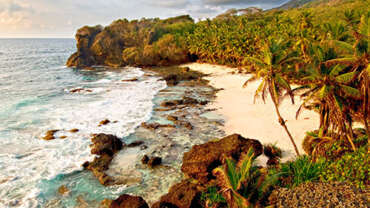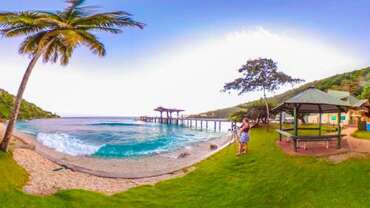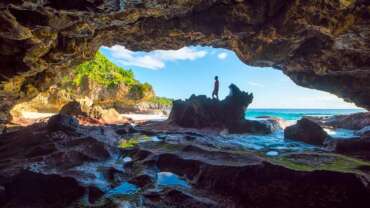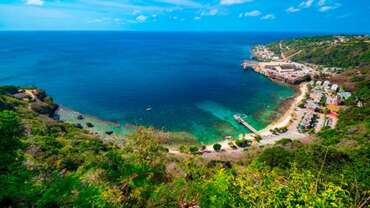Experiences in Christmas Island
There are many opportunties for extraordinary experiences on Christmas Island.
Christmas Island Red Crab Migration
Gecarcoidea natalis (Pocock, 1888)
The Christmas Island red crab is by far the most obvious of the 14 species of land crabs found on Christmas Island. It is estimated that 40 – 50 million of these bright red land crabs live in their preferred shady sites all over the island.
Characteristics
Physical Characteristics of Christmas Island Red Crabs
Bright red is the common colour but there are the occasional orange specimens and more rarely some purple animals. They are a big crab. An adult body shell (or carapace) may measure up to 116mm across. The Christmas Island red crabs’ carapace is round shouldered and encloses their lungs and gills. Their claws are usually of equal size unless one is a regrowing claw. Males grow larger overall than females, while females have a much broader abdomen and usually have smaller claws than males. However young Christmas Island red crabs all have the characteristic narrow abdomen of the male. The broader abdomen on the female Christmas Island red crab only becomes apparent in the third year of growth.
Christmas Island red crabs grow slowly, reaching about 40mm in carapace width after 4-5 years. They are sexually mature at this age and begin to participate in the breeding migrations.The Christmas Island red crabs moult their shells regularly during their early growth phases to match their increasing body size. Moulting usually takes place in the protected moist environment of their burrows. Mature Christmas Island red crabs probably moult only once a year, as their growth rate slows.
Read More
Diet
The Christmas Island Red Crab’s diet consists mainly of fallen leaves, fruits, flowers and seedlings. They prefer fresh green leaves but will eat any fallen leaves. They are not solely vegetarian, they will eat other dead crabs and birds, the introduced Giant African snail and palatable human rubbish if the opportunity presents itself. They have virtually no competition for their food resource due to their high numbers and dominance of the forest floor.
Habitat
The Red Crab Habitat
Although most common in the moist environment of the rainforest, Red Crabs live in a variety of habitats including coastal shore terraces, and even domestic gardens. Tall rainforest on deeper soils has the highest crab density. They dig burrows in almost every square metre of available soil or live in deep crevices in rock outcrops. For most of the year, a crab will settle in one place, living in their burrow. The crabs’ burrows have a single entrance tunnel which leads to a single chamber. Only one crab lives in a burrow and outside of the breeding season Red Crabs are solitary, and do not tolerate intruders into their burrows.
Red Crabs are diurnal (active during the day) and almost inactive at night despite lower temperatures and higher humidity. They take great care to conserve body moisture and this seems to be the single most important factor influencing the crab activity. Sensitivity of crabs to moisture, combined with the seasonal climate on Christmas Island, create a distinct seasonal pattern of activity. Crabs retreat into the humid interior of their burrows during the dry season. They plug the burrow entrance with a loose wad of leaves to maintain a high humidity level, and effectively disappear from view for up to two to three months of the year.
Migration
The Annual Migration To The Ocean
At the beginning of the wet season (usually October / November), most adult Red Crabs suddenly begin a spectacular migration from the forest to the coast, to breed and release eggs into the sea. Breeding is usually synchronized island wide. The rains provide moist overcast conditions for crabs to make their long and difficult journey to the sea. The timing of the migration breeding sequence is also linked to the phases of the moon, so that eggs can be released by the female Red Crabs into the sea precisely at the turn of the high tide during the last quarter of the moon. It is thought that this occurs at this time because there is the least difference between high and low tides. The sea level at the base of the cliffs and on the beaches, where the females release their eggs, at this time varies the least for a longer period, and it is therefore safer for the females approaching the water’s edge to release their eggs. Sometimes there are earlier and later migrations of smaller numbers of crabs but all migrations retain this same lunar rhythm.
The main migration commences on the plateau and can last up to 18 days. Masses of crabs gather into broad “streams” as they move toward the coast, climbing down high inland cliff faces, and over or around all obstacles in their way, following routes used year after year for both downward and return migrations. Movement peaks in the early morning and late afternoons when it is cooler and there is more shade. If caught in open areas, in unshaded heat, the crabs soon lose body water and die.
Breeding
The Breeding Calendar
Males lead the first wave of the downward migration and are joined by females as they progress. Larger males arrive at the sea first (after about 5-7 days) but are soon outnumbered by females. The crabs replenish moisture by dipping in the sea, then the males retreat to the lower terraces to dig burrows. The density of burrows is high (1-2 per square metre and fighting occurs between males for burrow possession. The females move to the terraces and mating occurs, usually in the privacy of the burrows that males have dug and fought for. As mating and fighting abates, males dip again and begin returning inland. They move quickly, reaching the plateau in only 1-2 days.
The females produce eggs within 3 days of mating and remain in the moist burrows on the terraces for 12-13 days while they develop. The eggs are held in a brood pouch between their extended abdomen and thorax. A single female can brood up to 100,000 eggs.
In the morning and late afternoon around the last quarter of the moon, the egg-laden females descend from the terraces to the shoreline. They pack into shaded areas above the waterline at densities of up to 100 per square metre in places. The females usually release their eggs into the sea toward dawn, around the turn of the high tide. Release of eggs may occur on 5-6 consecutive nights during the main breeding migration. After the first two days, eggless females may be seen crossing plateau roads, kilometres from the shore.
If the spawning migration is delayed or disrupted, usually because of unfavorable weather conditions, both male and female crabs will remain on the terraces for the next month and complete the spawning one lunar month later.
Spawning
Spawning can happen as early as October and as late as January but November and December are the more usual months.
The migration comprises a sequence of events that follow on from one and other in a distinct order – a following sequence cannot be undertaken without the crabs having accomplished the preceding.
The crabs will migrate to the coast where the males will dig mating burrows and they will mate. After mating, the males will commence their return migration. The females will brood their eggs for 12-13 days before emerging from the burrows to commence spawning. The females will commence their return migration immediately after spawning.
The eggs hatch into free swimming larvae immediately after they are dropped into the sea. The larvae grow through several stages in the ocean for over four weeks before emerging from the sea to become tiny crabs.
Road closures are enacted in the National Park and other areas on the island to protect the migrating crabs.
Larvae
The Larvae Grow To Baby Crabs In The Sea
The eggs released by the females hatch immediately on contact with the sea water and clouds of young larvae swirl near the shore before being washed out to sea by waves and tides. Millions of the larvae are eaten by fish and plankton feeders such as Manta Rays and the enormous Whale Sharks which visit Christmas Island waters during the crab spawning season.
After about a month in the ocean, and after growing through several larval stages, the surviving larvae have developed into prawn-like animals called megalopae. The megalopae gather in pools close to the shore for 1-2 days before changing into young crabs and leaving the water.
Although only 5mm across, the baby crabs begin their march inland, taking about 9 days to reach the plateau. Here they seem to disappear and are rarely seen, living in rocky outcrops and under fallen tree branches and debris on the forest floor for the first three years of their life.
Some years very few or no baby crabs emerge from the sea, but the very successful years are enough to maintain the Red Crab population at a high level.
Human Impact
Certain human activities have led to increased numbers of Red Crabs dying during their annual migration to the sea. As well as there being a greater risk of crabs dehydrating when forced to cross areas cleared of forest cover, thousands of adults and young are crushed by vehicles while crossing roads. Some have to negotiate up to three or four such hazards on their descent and ascent each year. Conservation measures have been implemented to help reduce this high death toll.
To reduce the number of crabs killed by vehicles during the migration, ‘crab crossings’ have been constructed in roads which cross main crab migration paths. Points where high numbers of Red Crabs cross roads have been identified, and tunnels are built under the road for crabs to pass through. Walls that the crabs can not climb over are built alongside the road to ‘funnel’ the migrating crabs through the tunnels. Christmas Island is home to the world’s only “crab bridge”. Crabs climb the bridge which takes them over one of the island’s busiest roads. Other conservation measures used by the community are road closures and traffic detours around the major migration paths during peak periods of the migration.
Scuba Diving & Snorkelling
Want to Scuba Dive on Christmas island?
Christmas Island boasts some of the best scuba diving trips in Australia and has some of the longest drop-offs in the world. The island rises dramatically from the edge of the Java Trench, the Indian Ocean’s deepest point. This contributes to the endless kilometres of spectacular drop-off diving with most walls being only 20 metres from the shoreline.
Our scuba diving trips boast spectacular wall diving, untouched corals, hundreds of species of tropical fish, dolphins, whalesharks, warm clear water, the opportunity to see magnificent marine life – what more could you expect from the ultimate scuba diving trip and experience?
Christmas Island is surrounded by a narrow tropical reef which plunges into a bottomless abyss. This makes it the perfect destination for scuba diving trips! This reef is laced with many unspoiled corals and abundant species of marine life. The northern coast in particular boasts some of the most unspoiled corals in the world such as Acropora and plate corals which play host to a wide variety of small tropical species such as surgeon fish, wrasse, butterfly fish, gobies, anemones, eels and many others which are a photographers delight.
You may also be paid a visit by one of the larger locals on your scuba diving trip. Pelagics like rainbow runner, trevally, wahoo and tuna cruise along the walls and the occasional shark comes up for a curious look.
You could be graced with the presence of the majestic whaleshark. An encounter with one of these gentle giants who often visit any time between November and April is an experience on your scuba diving trip that you’ll never forget!
Snorkelling
With coral reefs surrounding the Island, snorkelling is a must on every visit to Christmas Island as the abundance of fish and coral to see is breathtaking, just a few metres from the shore. Popular and accessible Flying Fish Cove is great for snorkelling and swimming.
When the waters are too rough at Flying Fish Cove, head over to Ethel Beach which may offer sheltered water and an equally dazzling array of fish and corals.
We recommend that reef shoes be worn on our beaches. Visitors can bring reef shoes with them or purchase them once on island.
Bird Watching
If you are looking for an unforgettable birdwatching holiday, you will love Christmas Island. 63% of the island’s 135 square kilometres is national park and the island’s close proximity to South East Asia and the equator has resulted in a diverse range of bird species.
The island is large enough to have developed its own unique rainforest ecology. There are hundreds of species of birds with seven of the 13 land birds being endemic to the island, including the inquisitive Christmas Island Thrush, whose melodious evening song lends a wonderful musical quality to the tropical, palm-fringed sunsets.
Truly special sightings for those on a birdwatching holiday
Many species are quite inquisitive and those on a birdwatching holiday can be rewarded with some truly special sightings. Highlights include the rarest booby and frigate birds in the world, the Abbotts Booby and the Christmas Island Frigatebird. With little effort is it quite easy to tick off a full list of residents in a busy week or more relaxed fortnight, though the elusive Christmas Island Hawk Owl keeps many coming back for more!
Photography
Christmas Island in your lens
It’s hard to imagine a more visually tantalising place to photograph than Christmas Island. All around you are sights, colours, textures and landscapes you’ll want to capture, so bring nature to life through your lens. From soft, pastel sunrises to glorious sunsets, Christmas Island is bathed in ever-changing tropical light. Vivid colour is everywhere, from the crabs’ rich reds to the rainforest’s deep greens, to turquoise waters. Catch the robber crabs on film, zoom in on gentle orchids and twisting vines, and train your lens skywards to capture the elegance and freedom of rare birds in flight.
Underwater photographers have a kaleidoscope of colours and shapes to shoot. On land the imposing, inspiring and detailed architecture of temples and other built form keeps shutters clicking.
Video cameras capture the sights and sounds of millions of scurrying red crabs, or the hauntingly musical call of the island’s thrush, and the stirring call to prayer from the mosque.
Best spots for best shots
Martin Point – for staggeringly beautiful sunsets and seabirds.
Blowholes – capture the energy of the water on a rugged coastline.
Dolly Beach – impressively large robber crabs plus turtle tracks.
Hughes Dale Waterfall – an iconic island place for your unique shot.
Blowholes Road – get creative with a special tree along the road.
Greta Beach – nesting turtles all year round make wonderful pictures.
Island temples – rich colours fused with wisps of incense smoke.
Tai Jin House – capture the detail of this building and its gardens.
Flying Fish Cove – for underwater photography.
Fishing on Christmas Island is a truly unique experience. Really, anything is possible!
Breathtakingly steep drop-offs enable anglers to target big blue water fish within ridiculously short distances from the shoreline. Whether it be trolling for pelagic species such as tuna, wahoo or sailfish, casting lures for the mighty giant trevally, or jigging for the iconic dogtooth tuna, it can mean just a two minute cruise from the boat ramp before it’s time to put the lures in the water.
From December through to April the monsoon, or swell season, can limit boat fishing opportunities. When conditions allow, trolling is the most productive and easiest way to catch yourself a fish. However, for the experienced angler the options are far greater. If it’s not the big fish you are after, you can drop a line from the jetty at Flying Fish Cove or one of the many spots along the cliff tops. Land based fishing is possible year round, though at its best during the swell season. Through the dry season, when the fish multiply in both size and numbers, there is nothing quite like catching a big fish on a jig or topwater lure. This is where the fishing experience on Christmas Island really excels.
Christmas Island Golf Course
Golf is one of the favourite pastimes of Islanders and the Golf Course is well worth a try for professional golfers or first timers. The 9-hole golf course is situated amongst palm trees and tropical rainforest with a magnificent view of the Indian Ocean. Green Fees of $15 per round. Clubs are available for hire from the Christmas Island Visitor Centre and visitors are most welcome. Christmas Island Frigate Birds nest inland from the course and land crabs can be a local hazard.
Visitors are most welcome to have a hit or join in Ladies Golf (Wednesday afternoon), Mens Scroungers (Friday afternoon) or the weekend competition.
Christmas Island Golf Open 2020
If you fancy hitting a club amidst a spectacular backdrop with little red crabs crawling the greens, the Christmas Island Golf Open is the event you should be a part of. Hosted by the Christmas Island Golf Club and sponsored by Acker, experience playing golf on one of the most remote Australian Golf Courses, meet the locals and enjoy a series of competitive events which will ensure you get the most of your visit to the island.
Freedive at Christmas Island
What makes Christmas Island one of the best freediving locations in the world?
Perfect water temperature, 26-30 degrees all year round
Very little or no current in most dive locations, courses take place in Flying Fish Cove which is protected from currents. “The Cove” is surrounded by high cliffs that protect it from the winds and swell that prevail from the south east most of the year.
Great visibility, usually 20+ metres
Accessible dive locations, with most being a short swim from the beach at Flying Fish Cove or a short boat ride of under 15 minutes
Spectacular marine life, free dive with an abundance of pelagic, reef and tropical fish, spectacular coral and even whale sharks (November to April)
History and Culture
Christmas Island has a fascinating history and culture which has formed a unique community, architecture and landscape.
You are encouraged to try authentic local experiences through food, celebrations and joining in with community regular and special occasions. A monthly ‘What’s On’ provides the latest information to help you plan your visit.
Take the time to explore the built landscapes and discover temples, historic buildings, old cemeteries and ruins. For a glimpse of the past visit the Exhibition at Tai Jin House, the former District Officer’s Residence and the Chinese Museum on Gaze Rd.
Soft Adventure
Christmas Island is an adventure playground with amazing places to experience.
You can choose your own adventure in the jungle by car, foot, mountain bike or a combination. With 63% of the Island being National Park there are boardwalks and marked trails and more difficult walks for the fitter and more adventurous along paths less trodden. A network of roads and trails can be explored by car or mountain bike. Driving is as much about the journey as the destination as scenic roads wind through the rainforest. Many of the roads are unsealed and may be rough, so take into account your and your vehicle’s ability. The adventure steps up in the wet season when roads can be closed for the crab migration or if washed out by the rain, so check before you set out. Unless you are taking a leisurely ride along the coastal plateau it is a tough ride up the hill to the jungles and exhilarating on the way down. Bikes are available to hire through Extra Divers. If you are bringing your own bike, please make arrangements with the airline or agent when booking.
The underwater world is just waiting to be explored with a myriad of corals, fish and other species in the clear, blue waters. Snorkelling and diving is accessible from the beach or with one of our dive operators. If you are thinking about getting your dive ticket there is no better place to learn or to refresh your skills.
Christmas Island is a tropical environment so take into account the heat and humidity when planning your activities. It’s warm all year around. The wet season extends from around November to April. Temperatures vary little from month to month an average high of around 28 degrees C in April and an average low of around 22 degrees C in August. Humidity ranges from 80 to 90 per cent year-round but is generally lowest during the middle of the year.
Shopping & Restaurants
Tastes of the Tropics
Christmas Island’s restaurants showcase its rich cultural mix. From spicy Asian fare to modern western cuisine often crafted to highlight fresh, local product, you will find something delicious to suit your taste buds.
Restaurants, cafes and pubs offer a variety of styles, from traditional grills to colonial settings to laid back, casual pub options. Many offer the chance to relax over your meal while appreciating stunning outlooks.
Take advantage of the islands’ many picnic and barbecue venues, and pack your own hamper from supplies available at the local shops.
Cafe and restaurant options may be limited during Ramadan, Chinese New Year and Christmas – contact the Visitor Centre for further information as to what cafes/restaurants will be open during your visit.
As most food on Christmas Island is imported the cost for food and meals may be higher than other places to cover the additional transport.
Shopping
A visit to Christmas Island is like taking a step into another world. There are no shopping malls and opening times are varied and short, allowing you to spend more time exploring this natural wonder.
There are a small variety of shops and galleries which offer an excellent range of t-shirts, beach and bespoke fashion, souvenirs, gifts, homeware, handcrafted jewellery, photography and art, snorkelling gear, fishing tackle, pharmaceuticals, groceries, and duty free items.



